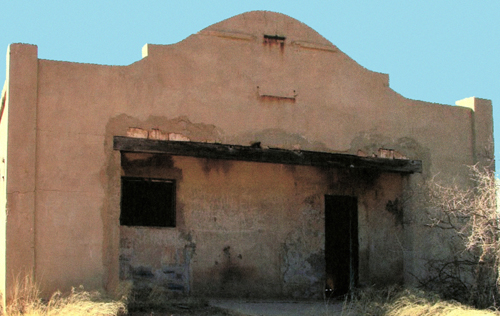





Every day, Tina Miller and John Wiest would pass the Gleeson jail on their way to and from their home just south on High Lonesome Road. As the owner of the Tombstone Mercantile Co., a small antique and western collectible store in Tombstone, Tina was fond of antiques and the history they bring, and so it was bothersome to see the deteriorated and vandalized condition of the old jail.  Beams had rotted nearly away, windows and doors had been torn out, walls were crumbling, and graffiti covered the peeling plaster. They assumed that the jail was government property, but still wondered if something might be done to save this historic building.
Beams had rotted nearly away, windows and doors had been torn out, walls were crumbling, and graffiti covered the peeling plaster. They assumed that the jail was government property, but still wondered if something might be done to save this historic building.
In the summer of 2008, they enlisted the help of a real estate title expert, and found that the jail and the surrounding property had been bought (sight unseen) at a tax sale by someone in Holland. In September of 2008, Tina and John purchased the jail and 10 acres of land, including the Martinez house to the west. Their title even included High Lonesome Road where it runs in front of the jail. That month, they began the restoration of the historic property. Both Tina and John value the outdoors and the rich history of the West. John had recently moved to Arizona from Wyoming, where he packed for an outfit in the Wind River Range for 10 years after leaving a 30 year career as a research chemist. Tina’s association with Cochise County, and the Tombstone region in particular, have resulted in personal and business connections throughout the area.
The first task was to get the jail evaluated for structural soundness. Built in 1910, it was constructed of poured concrete, reinforced by a dazzling variety of steel pieces. Railroad ties, re-bar, and many other types of steel run throughout the floors, walls, and even the roof. It was the strength of this structure, especially the reinforced roof, which allowed the jail to withstand 100 years of wind, weather, and vandals. So many other buildings of that era exist no more, their collapse accelerated by the destruction or dismantling of the roof. A missing chunk of the floor in the south jail cell has been left unfilled, so that the railroad rail can still be seen inside it.
 Restoration of the roof and the structural beams were the next order of business. The roof was repaired, sealed, and coated, rendering it waterproof. This would protect the rest of the structure. Beams were replaced in the front wall, where 75% of it had been torn out. The barred windows, which had been torn out by the County in 1938 for use in the Benson jail, were re-built, and a door was placed in the main entryway so that renovations of the inside could proceed.
Restoration of the roof and the structural beams were the next order of business. The roof was repaired, sealed, and coated, rendering it waterproof. This would protect the rest of the structure. Beams were replaced in the front wall, where 75% of it had been torn out. The barred windows, which had been torn out by the County in 1938 for use in the Benson jail, were re-built, and a door was placed in the main entryway so that renovations of the inside could proceed.
A photograph was unearthed in Texas of the jail when it was first built, and so the “JAIL” sign and the “1910” date were duplicated and mounted in their original locations. A rustic wire-and-stay fence was constructed to set the building off, and parking space was cleared and bulldozed around it to accomodate visitors.
 Bit by bit, the interior was filled with artifacts from the early 1900’s. A local historian provided some stories which shed light on the history and lore of both the jail and the town of Gleeson. Some of these stories have been “illustrated” by exhibits of artifacts inside the jail. Tina’s attention to detail, and her eye for genuine period antiques, have helped to re-create the Gleeson jail during its boom period.
Bit by bit, the interior was filled with artifacts from the early 1900’s. A local historian provided some stories which shed light on the history and lore of both the jail and the town of Gleeson. Some of these stories have been “illustrated” by exhibits of artifacts inside the jail. Tina’s attention to detail, and her eye for genuine period antiques, have helped to re-create the Gleeson jail during its boom period.
It its second life, the Gleeson jail has become a gathering place for local people, returning long-lost residents, family history buffs, and just plain folk who are interested in both the Old West and the transition to the New West.
In February of 2014, when the jail was a spry 103 years old, it was sold to Joe Bono. That's right...the same Joe Bono who was born in Gleeson and whose father owned the Bono General Store, right across the highway. THAT Joe Bono!, And in the tradition of Gleeson and Bono family hospitality, he continues to offer interested visitors an informal place to share a bit of history.